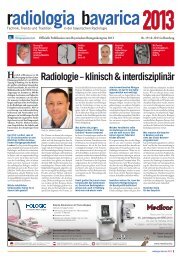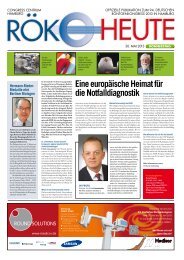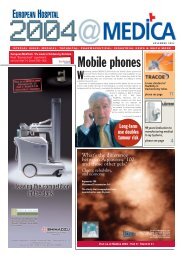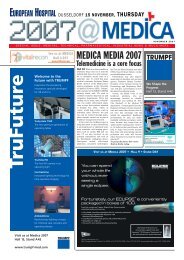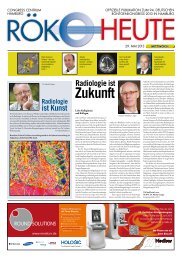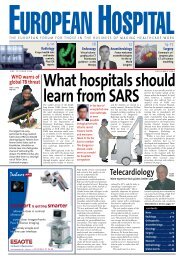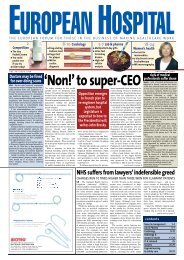PET scanning the heart cuts costs - European-Hospital
PET scanning the heart cuts costs - European-Hospital
PET scanning the heart cuts costs - European-Hospital
Create successful ePaper yourself
Turn your PDF publications into a flip-book with our unique Google optimized e-Paper software.
Money and mammography<br />
Could a fully digital breast imaging service be financially viable?<br />
USA - North-Western Medical<br />
School has used Activity Based<br />
Costing (ABC) to analyse five major<br />
services provided by its mammography<br />
section: screening, diagnostic,<br />
breast ultrasound (US), interventional<br />
procedures, and reviews of external<br />
mammograms.<br />
The ABC analysis revealed that<br />
only two services showed a profit,<br />
screening mammography and intervention<br />
procedures. There was no<br />
consistent relationship between <strong>the</strong><br />
financial contribution of <strong>the</strong> service<br />
and <strong>the</strong> total mammography volume<br />
and <strong>the</strong>refore no economy of scale.<br />
This suggested that <strong>the</strong> more a service<br />
is provided, <strong>the</strong> greater <strong>the</strong><br />
financial loss. When indirect <strong>costs</strong><br />
were included in <strong>the</strong> cost structure all<br />
<strong>the</strong> mammography programmes in<br />
<strong>the</strong> survey registered losses.<br />
The report pointed out that <strong>the</strong><br />
term ‘mammography’ refers not to a<br />
single examination but to a set of<br />
diagnostic procedures, <strong>the</strong> most com-<br />
mon and familiar being screening<br />
mammography, in which <strong>the</strong> examination<br />
consists of two standard<br />
views of each breast interpreted by<br />
<strong>the</strong> radiologist. The ACR-published<br />
standard for diagnostic mammography<br />
defines it as a problem-solving<br />
breast evaluation, which is indicated<br />
by a particular concern. However,<br />
using computer-aided diagnosis in<br />
screening mammography may<br />
increase <strong>the</strong> inexperienced image<br />
reader’s sensitivity to breast cancer<br />
and so give more false-positive interpretations.<br />
This leads to an increase<br />
in <strong>the</strong> number of diagnostic mammograms<br />
and a reduction in productivity.<br />
Diagnostic mammography on <strong>the</strong><br />
o<strong>the</strong>r hand is a much more comprehensive<br />
examination and consists of<br />
customised views of <strong>the</strong> breast<br />
depending on <strong>the</strong> findings of concern<br />
and may involve tailored or comprehensive<br />
imaging analysis. Often<br />
associated with diagnostic mammography<br />
<strong>the</strong> interpretation of outside<br />
mammograms can be time-consuming.<br />
In a negative financial outcome<br />
for diagnostic mammography <strong>the</strong>se<br />
three examinations, each with a loss<br />
per procedure, were often grouped<br />
in delivering comprehensive breast<br />
ONCOLOGY NEWS<br />
imaging services. In addition, <strong>the</strong> volume<br />
of different procedures was interrelated;<br />
growth in screening mammography<br />
being followed by growth<br />
in diagnostic mammography, breast<br />
US, and interventional procedures.<br />
Breast centres with a good reputation,<br />
due to referrals, have a higher proportion<br />
of diagnostic mammograms and<br />
difficult outside mammograms, and<br />
because <strong>the</strong>se are provided at a financial<br />
loss per examination, <strong>the</strong>re are<br />
economic disincentives in concentrating<br />
high-quality mammography talent.<br />
The new digital mammography<br />
environment promises to change <strong>the</strong><br />
entire practice of mammography in<br />
terms of who and how and where<br />
digital mammograms are acquired,<br />
interpreted, and stored. But migrating<br />
from a film-based examination to a<br />
fully digital one will require substantial<br />
capital investment. Clearly a<br />
financially self-supporting mammography<br />
service would facilitate this<br />
transition. The report concluded that,<br />
to realise <strong>the</strong> real benefits of a fully<br />
digital breast imaging service, a different<br />
financial environment would be<br />
needed.<br />
Report by Peter Howieson<br />
Superheat<br />
system success<br />
Boosting <strong>the</strong> effects of<br />
radiation and chemo<strong>the</strong>rapy<br />
Germany - Interest in a <strong>the</strong>rapy system<br />
named BSD-2000 has increased<br />
significantly since a Phase-III<br />
<strong>European</strong> trial, involving patients<br />
with advanced cervical cancer,<br />
showed that radiation combined with<br />
<strong>the</strong> system resulted in an almost a<br />
50% higher survival rate than for <strong>the</strong><br />
patients treated with radiation alone.<br />
To date, six systems have been<br />
installed in Bavarian clinics alone<br />
and, in April, <strong>the</strong> seventh BSD-2000<br />
system will become operational at <strong>the</strong><br />
Schlossberg Clinic, in Oberstaufen.<br />
The system’s manufacturer, <strong>the</strong> USbased<br />
BSD Medical Corporation,<br />
which develops microwave and radio<br />
frequency systems for <strong>the</strong>rmal medicine<br />
applicable to <strong>the</strong> treatment of<br />
cancer, benign diseases and o<strong>the</strong>r<br />
medical conditions, explained that its<br />
cancer treatment systems are used to<br />
superheat and kill cancer cells and to<br />
boost <strong>the</strong> effectiveness of radiation<br />
and chemo<strong>the</strong>rapy. ‘The BSD-<br />
2000/3D employs a revolutionary<br />
annular phased array of 24 dipole<br />
radiofrequency (RF) antennae placed<br />
around <strong>the</strong> patient to focus RF energy<br />
steered in 3D on <strong>the</strong> cancer.<br />
Cancers targeted are primarily those<br />
located deep in <strong>the</strong> body, such as colorectal,<br />
bladder, ovarian and prostate<br />
cancer.’<br />
The firm added that <strong>the</strong><br />
Schlossberg Clinic (a member of <strong>the</strong><br />
Munich Comprehensive Cancer<br />
Centre, and holder of a clinical cooperation<br />
contract with <strong>the</strong> LMU<br />
Munich University Medical School at<br />
Klinikum Grosshadern, which specialises<br />
clinical cancer research) will<br />
use <strong>the</strong> system in combination with<br />
chemo<strong>the</strong>rapy and radiation, in a<br />
pilot project that could lead to use of<br />
<strong>the</strong> BSD-2000/3D in o<strong>the</strong>r centres<br />
owned by <strong>the</strong> Humaine Kliniken<br />
Group.<br />
Details: www.BSDMC.com<br />
EUROPEAN HOSPITAL Vol 14 Issue 2/05 9



